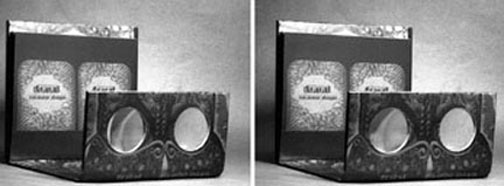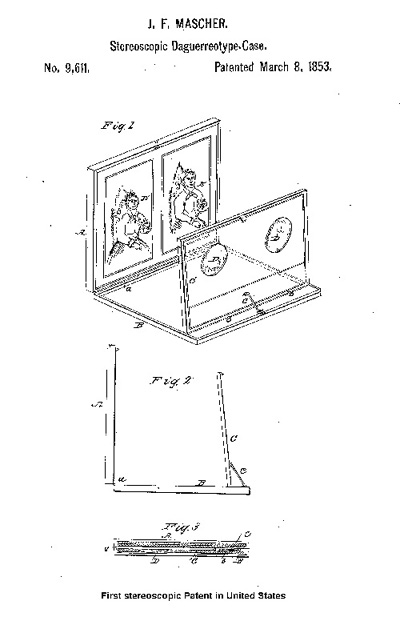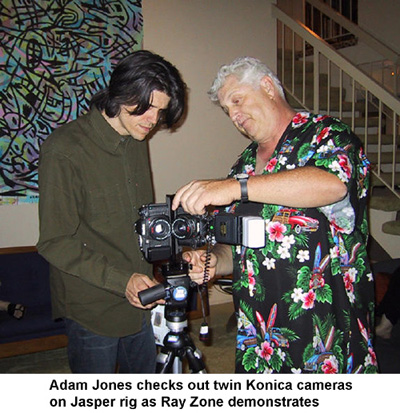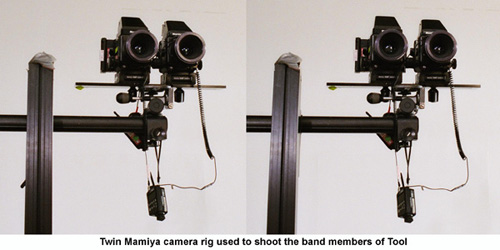

The Tool 3D CD, "10,000 Days," released May 1, 2006, is the first music CD packaged with a stereoscope. This design uses a folding stereoscope with two fixed-focus magnifying optical lenses for viewing stereo pairs of images in a booklet that itself folds flat. The stereo viewing configuration has been used in recent years with books such as Mark Blum's "Bugs in 3-D"(Chronicle Books: 1998) and "3D Museum" by Makoto Sugiyama (Shogakukan: 1995).
This folding 3-D book design is actually based on the very first stereoscopic Patent granted in the United States. The Patent (No. 9,611) by J.F. Mascher is titled "Stereoscopic Daguerreotype - Case" and is dated March 8, 1853.

In September 2003, I met Adam Jones, guitarist of Tool and art director for the 3D CD, at a party given by Glenn Bray and his wife Lena at their home in Sylmar, California. It was the day of the 3D Bizarre magazine shoot. When I came to the party I brought along the twin-camera rig that had been used for the Bizarre magazine 3D shoot earlier in the day. This was a twin camera rig that used two Konica's vertically arranged on a Jasper Engineering rig with lenses that had been matched by Paul Wing.

Adam was very interested in the twin camera rig. I used the rig at the party to shoot stereo portraits of different people who were there including comic book and cartoon celebrities such as Robt. Wms, Chip Kidd, Coop, Matt Groening, Monte Wolverton and Savage Pencil as well as Adam Jones. Subsequently, Adam became a member of the Stereo Club of Southern California. Two years passed and then I received an email from Adam. He was ready to begin production on the new Tool CD packaging. In September 2005, Adam and I took a meeting at Tool's management company. Adam had a copy of the folding stereoscopic viewer book "Peepshow" at the meeting and wanted to package their forthcoming CD that way. I was hired as stereoscopic consultant to produce and oversee 3-D photography, check quality control and design parameters for the lenses to be used in the packaging and produce stereo conversions of Alex Grey art.
The four band members of Tool were all shot by Travis Shinn with a twin MF rig (two Mamiya RZ 6x7 camera bodies - 140mm focal length Zeiss lenses - 6.5 inch interocular). Before the shoot, Travis and Adam came over to my place and we looked at many stereocards in the Holmes stereoscope to consider various artistic options. When Travis assembled his stereo rig with the two medium format cameras, some basic math established that the nearest subject should be about 18 feet away from the cameras. The photographic stage that had been set up for stereo shooting used eight well-placed strobe lights around the stage activated by a radio control affixed to a hot shoe on the cameras. Travis also utilized Polaroid backs on the two MF cameras which produced instantaneous pairs of prints that were taped together for viewing in the Holmes stereoscope during the shooting.

Other cameras used were (Sean Isroelit's) RBT X4 and my Nikon FM2 with a winder (shooting side-step). The stereo shot of the falcon with the candles was made using Sean's RBT with the radio control for the strobes. For the actual shot, the candles were not lit so that the falcon would not be disturbed by the flames. As it was, every time I fired off the camera there was a powerful flash of light and the falcon would restlessly flap his giant wings. Later, the candles were lit and the stereo photography was composited into the shot of the falcon using Adobe Photoshop. Close-up stereo shots of details on the stage were shot with my Nikon FM2 using a side-step with the strobes going off for each of the left and right eye exposures.
Using Adobe Photoshop, I did three stereo conversions of Alex Grey art that are in the booklet. There are also 3 CG 3D pieces by Meats Meier and Bayard Baudin who I instructed in using Maya software to create stereoscopic images. This was a relatively simple procedure where a second camera view was produced in the software so that a stereo pair was created of the CG imagery. Both Meats and Bayard produced stereo pairs in the Maya software (version 7) using parameters I set for them such as the "one to thirty" rule (the interocular should be one-thirtieth of the distance to the nearest image in the field of view). The stereo pairs were reduced in size and printed out as a 3 1/2 by 7 inch stereo card and viewed in a classic Holmes stereoscope. When Meats and Bayard saw the results of their Maya manipulations through the stereoscope in 3-D, it was a magic moment. Both of them are now confirmed "stereoscopic" 3D computer aficionadoes.
Besides having the opportunity to work with state-of-the-art photographic production techniques, the stereoscopic consultation on Tool's "10,000 Days" was very gratifying for me because it has been a great way to promote 3-D to many people who may not have previously seen it in this form.
564,000 copies of the Tool 3D CD sold in the first week of its release and it rocketed to the top of the Billboard Music Chart. With this release, a simple music download of Tool's unique sound will not satisfy. Fans of Tool will have to buy the 3D CD to get the complete experience of "10,000 Days." In 2006 at the 49th Grammy Awards, the "10,000 Days" 3D CD won a Grammy for "Best Recording Package."
